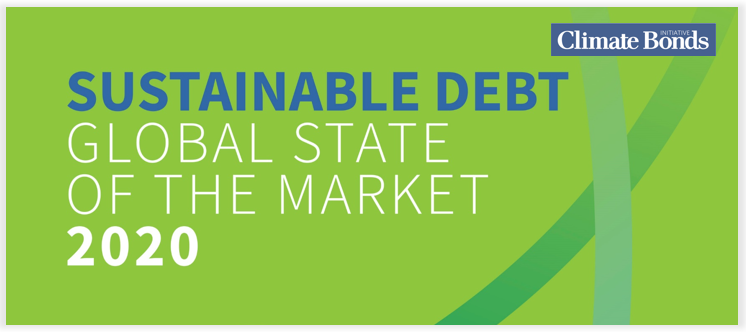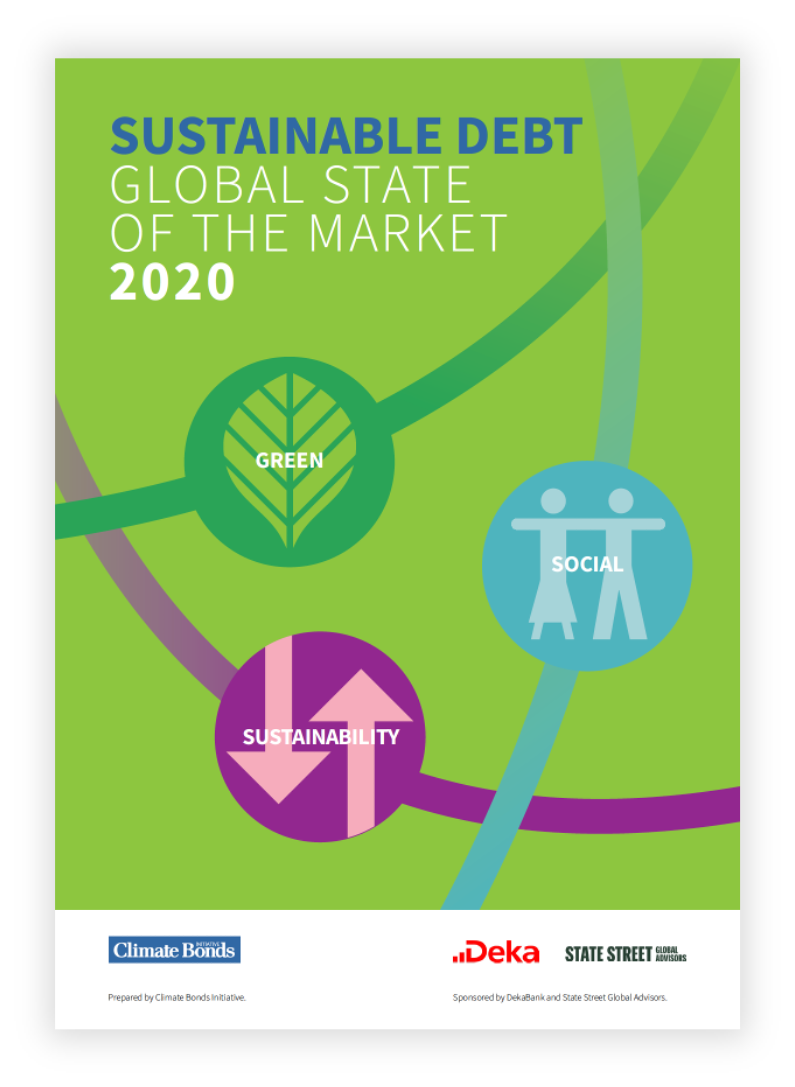10th iteration of Climate Bonds flagship report: Cumulative GSS issuance reaches $1.7tn in labelled markets: Cumulative Green passes $1tn milestone: 2021 set for another record high as momentum continues
The Big Headline
The sustainable debt market (green, social and sustainability bonds) reached a cumulative USD1.7tn at the end of 2020, with almost 10,000 instruments issued under GSS labels since 2006. While there is a long way to go it is clear that this pivotal decade has begun with labelled issuance emerging into the mainstream.
Cumulative green issuance stood at USD1.1tn, having reached the long-awaited USD1tn milestone in early Dec 2020, with sustainability bonds at cumulative USD316.8bn, followed very closely by social bonds at USD315.6bn.
USD700bn worth of GSS instruments was issued in the calendar year 2020, almost double the 2019 figure of USD358bn total, indicating the sharp growth in sustainable debt despite the impact of COVID-19.
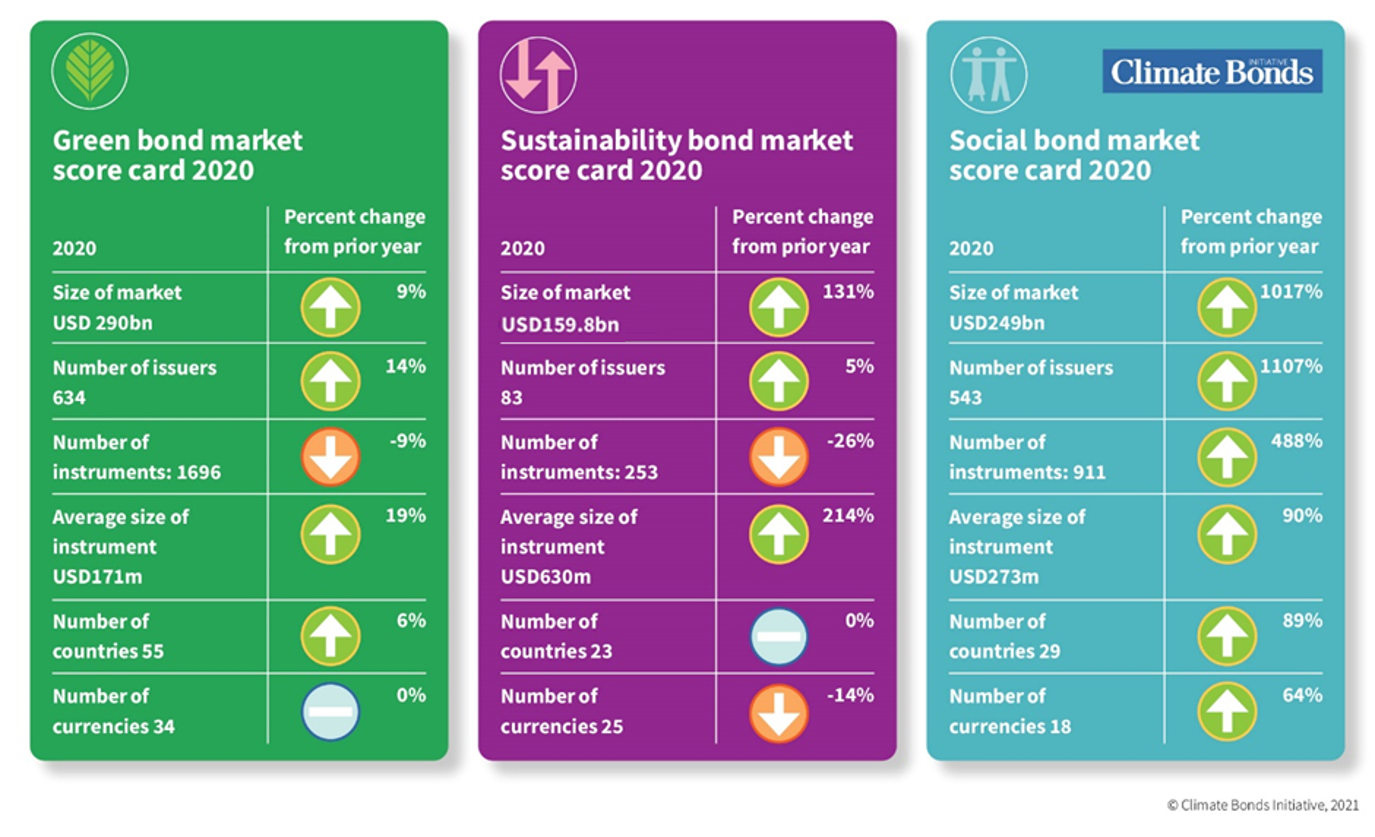
Social and sustainability bonds see dramatic growth
While green remains the dominant theme and was the largest source of outright capital, the social and sustainability themes grew dramatically and achieved higher volumes than all previous years combined. As a result, total issuance in 2020 was more evenly spread across the three major themes compared to prior periods.
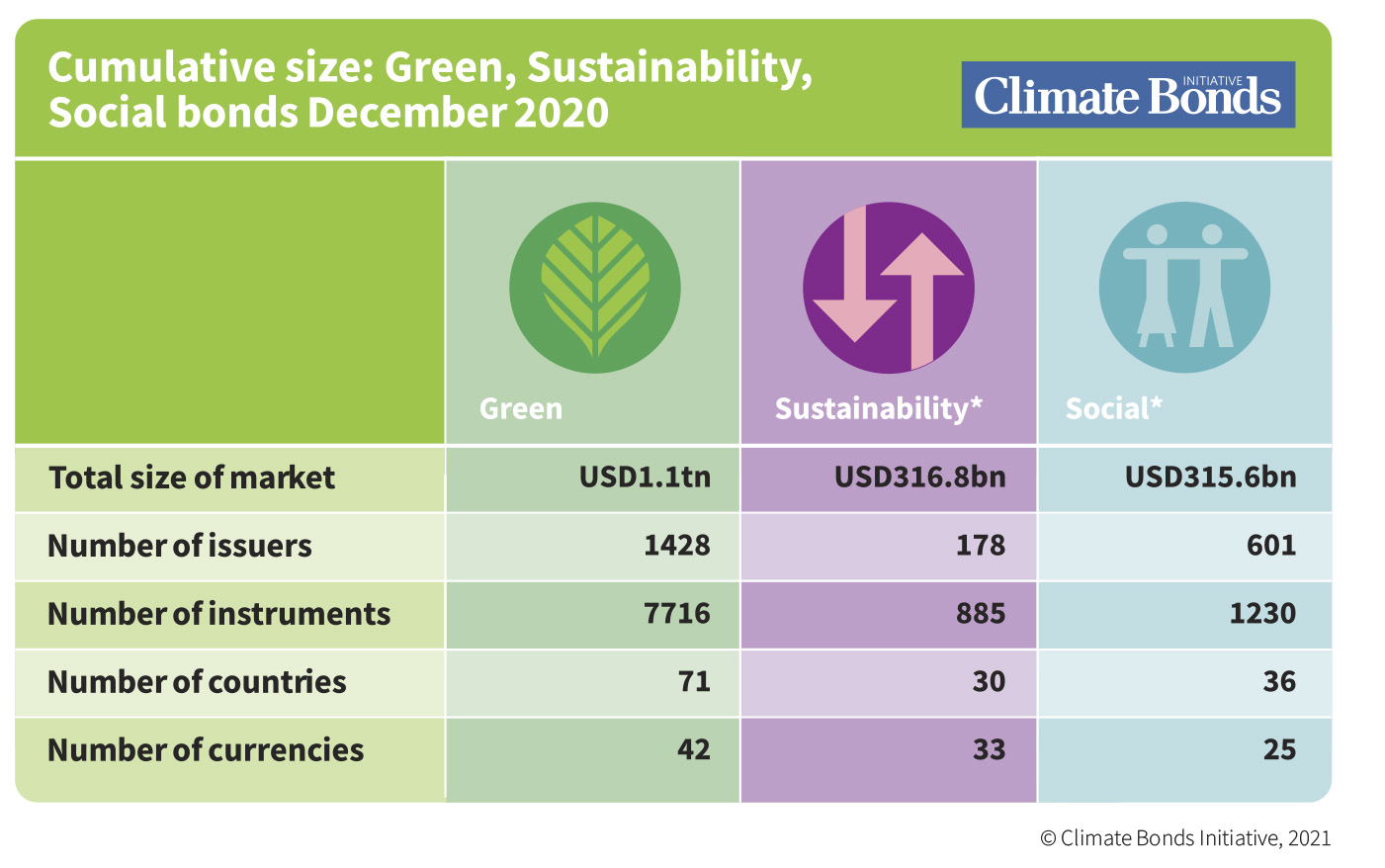
Sovereign GSS bonds
At the end of 2020, USD97.7bn worth of Sovereign GSS bond had been issued from 22 sources. Green remains the dominant label, but sovereign social bonds were issued for the first time in 2020 by Chile, Ecuador and Guatemala and Luxembourg, Mexico and Thailand, introduced sustainability bonds.
Sovereign issuance is a catalyst to the development of local markets; Climate Bonds is calling for a doubling of the number of green sovereign issuers to forty over 2021/2022.
Certification under the Climate Bonds Standard
2020 saw an acceleration with USD51.5bn of Certifications, passing the cumulative USD150bn mark in October and reaching a cumulative total of USD154.7bn by the end of December. Prominent Certified Issuers included Chile, the Netherlands and a host of large Chinese banks and urban transport authorities.
Climate Bonds certification criteria for Transition investment will be coming soon.
Green Bonds Overview
The record USD290bn issued in 2020 increase compared to 2019, after a solid third quarter. While the number of issuers increased, the number of instruments declined. The average size of the individual instruments issued under the green label is the smallest of the three themes, suggesting that the green debt market has broad appeal among a range of issuer types.
At a Glance:
- Four-fifths of the overall green volume originated from developed markets (DM) in 2020, compared to 73% in 2019. Emerging markets (EM) accounted for 16% versus 22% the prior year, while the contribution of supranational entities (SNAT) was 4% against 5% in 2019.
- Europe was the largest source of green debt in 2020, responsible for USD165bn or 48% of the total.
- North America remained broadly static on the prior year with USD61.5bn of green bonds compared to USD60bn in 2019.
- The green bond market in China felt the impact of COVID-19. Overall, bonds from Chinese entities reached just USD22.4bn, or 70% of the 2019 total of USD31.4bn.
- Together, Energy, Buildings, and Transport were respectively the three largest Use of Proceeds (UoP) categories, contributing 85% to the total in 2020. Energy and Transport, along with Land Use, were the only categories to expand in 2020.
Sustainability Bonds – Overview
In 2020 the amount of debt issued under the sustainability theme reached USD159.8bn, 2.3 times that of 2019. More issuers entered the market, and the size of the individual instruments was, on average, three times larger than the prior year. Individual instruments increased in size and were larger (on average) than those issued under the green or social labels.
At a Glance:
- In 2020, sustainability bond issuance increased by 131% compared to 2019. Overall, supranational entities (SNAT) accounted for 63% of the volume, Developing Markets for 32%, and Emerging Markets for 5%. This translates into growth for both SNAT and developed markets compared to 2019, while emerging markets volume dropped by 9% compared to the previous year.
- Most of the 260% growth from SNAT issuers originated from development banks, especially multilateral (MDBs). The main driver was the World Bank, but other players such as the Asian Infrastructure Investment Bank (AIIB) debuted sustainability bonds in 2020.
- Europe enjoyed solid growth of 43% (USD31.6bn versus USD22.2bn in 2019), making up 20% of total 2020 issuance and ranking second after SNAT.
- North America was among the regions showing the most impressive development. Issuance grew by 164% year-on-year from USD3.9bn to USD10.4bn.
Social Bonds – Overview
The social bond market exploded in 2020, with USD249bn representing a more than 10-fold increase (1022%) year-on-year, the sharpest annual growth in any theme since the inception of the GSS debt market. The number of issuers using social labels grew by 1107% from 45 in 2019, reaching 543 in 2020 and encompassed a broader range of countries and currencies than ever before.
The dramatic growth can be largely attributed to the effects of the COVID-19 pandemic and the increasing desire of bond issuers to address health and other social concerns in a more strategic way.
At a Glance:
- Issuance skyrocketed in nearly all regions in 2020. Overall, with the pandemic label as a sub-label of social bonds, all regions saw an increase in issuance apart from Africa.
- Pandemic bonds contributed substantially to the growth and accounted for 34% of 2020 social bond issuance.
- China with USD68bn of issuance and SNAT with USD77.7bn made the largest contributions to the 2020 issuance volume. France ranked third, with USD52.5bn and Japan fourth with a total of USD8.8bn.
Spotlight
The Sustainable Debt State of the Market Report, puts the spotlight on 3 key themes:
1. The development of transition instruments
No industry or entity can be left behind in the transition to a net-zero carbon economy and a more resilient and equal society. The development of instruments to accommodate a broader range of issuers and activities is essential in extending the thematic bond market and can help investors to build diversified portfolios.
2. Green recovery finance
We examine how four governments have implemented measures to ensure a sustainable recovery. Post-pandemic recovery spending linked to GSS expenditures encourages crowding in of investment by introducing more projects into the real economy.
3. European GSS leadership
Europe is home to the world’s largest green bond market, which has developed with the strong leadership of the EU. Multiple European nations have issued Sovereign GSS bonds. The EU has stated its ambition to be the first climate-neutral bloc by 2050, and this objective is being pursued by connecting policy and budget, regulation, and the support of institutions including the ECB.
Who’s saying what?
Rupert Cadbury, Fixed Income Portfolio Strategist at State Street Global Advisors:
“As we begin to recover from the impact of the COVID-19 pandemic, a backdrop of ever-growing interest in and actions on the climate emergency is being established. The potential of a green revolution that can drive and sustain this recovery will certainly be on top of the agenda in every country and business. From the UK government’s pledge to issue its inaugural green bond this summer, to the many discussions ahead of COP26 this November, all things point to the fact that a sustained global recovery will depend on more than just short-term stimulus packages, but rather on a comprehensive global effort to support the global transition to a net-zero economy.”
“With USD1.71bn of green bond investments, State Street Global Advisors has been an active investor in green bond issues globally since 2012. The Sustainable Debt-Global State of the Market report helps investors to understand and navigate the latest developments and trends in the GSS bond space and provides an important reference tool to formulate discussions with clients, as well as climate related initiatives and partnerships. Importantly it can also help drive our innovation, as we continue to develop climate related investment products and strategies for investors.”
Ingo Speich, Head of Sustainability & Corporate Governance, Deka Investment:
“Sustainable finance continues its drive despite the impact of the pandemic. This State of the Market report demonstrates the shift towards green and sustainable investment is underway and beginning to accelerate.”
“The finance sector has a vital role in ensuring this acceleration continues and Deka is committed to playing its part. Sustainability is a core element of our business model and the report signals the pathways that all stakeholders, banks, investors, issuers and corporations can follow in the transition towards net zero.”
Sean Kidney, CEO, Climate Bonds Initiative:
“The green, social and sustainability markets have been at the foundation of climate-conscious recovery from the pandemic. A key feature of the 2020 labelled bond market is the broadening and deepening of thematic issuance. The emergence of a transition label points towards the pathways investors and corporates in basic industries must take towards net zero. The rise of social and sustainability issuance indicates welcome market developments towards building resilience and adaptation measures as part of sustainable development.”
“2020 was a demonstration that business-as-usual economic policy is not sufficient to address multiple and sustained shocks of the sort that climate impacts will increasingly drive. The gap between current investment levels and the sustained flow of global capital in trillions towards climate and green solutions is yet to be bridged.”
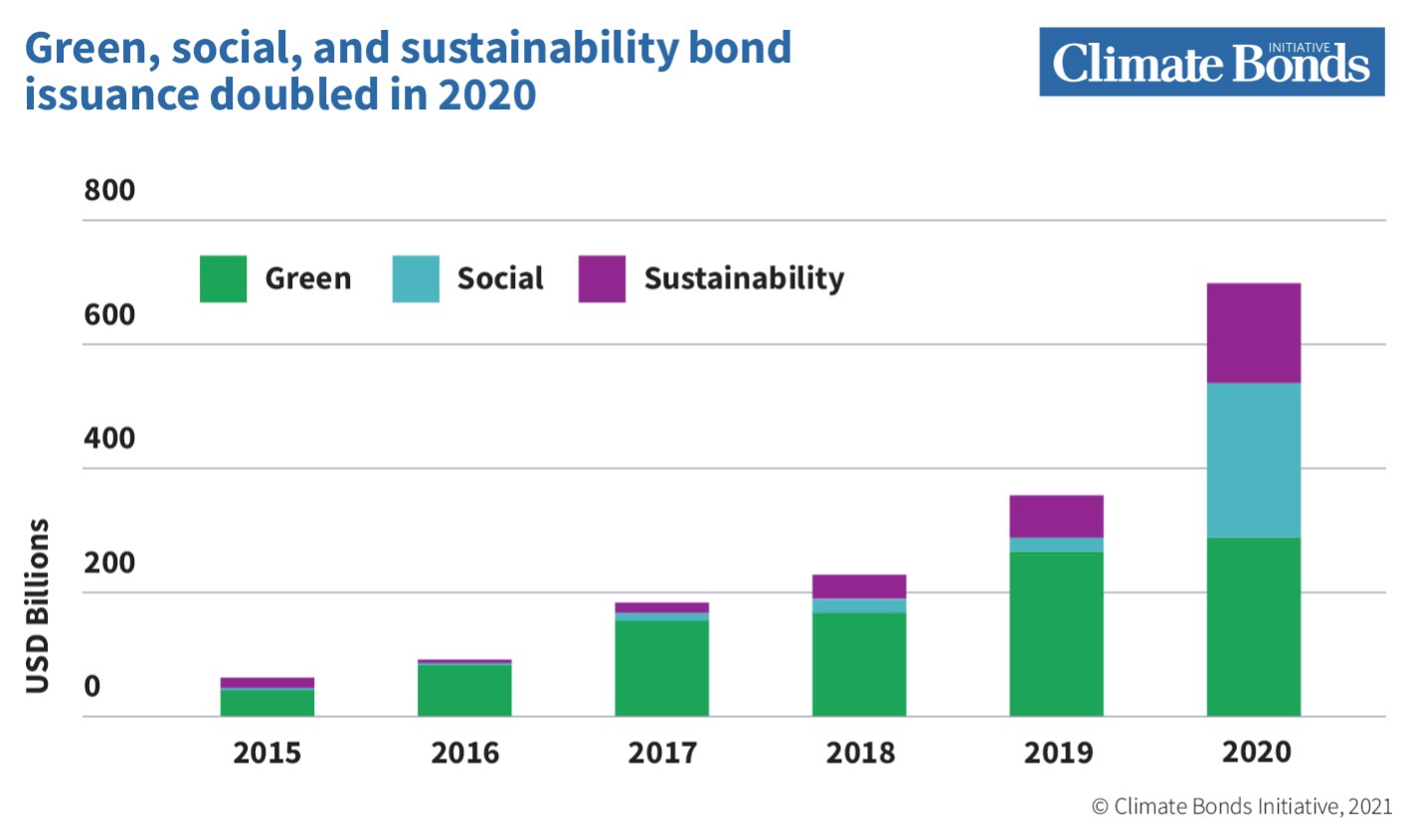
Looking Ahead
We expect 2021/22 to enable a sustained resurgence in GSS markets, increasingly driven by policy support such as that being displayed by the EU and national net-zero commitments, including those from China and the US. Amongst the drivers will be a White House committed to climate action, the potential for a new climate triple-axis between the US, China and the EU, and the shift towards transition-based investment.
Better investor understanding of climate risks will stimulate longer-term demand for GSS products as sustainability is increasingly embedded in investment and financial market infrastructure through the EU Sustainable Action Plan/ Taxonomy, CBFR activity.
Further out, forecasting group the Inevitable Policy Response (IPR) sees a coming acceleration of climate policy and targets via the 2023 Paris global stocktake and the 2025 ratchet.
Yet the cumulative USD1.7tn of GSS debt described in this report remains a small fraction of the global USD100tn bond market.
While policy and investor actions may set the pace towards the vital 2020s milestone of USD1tn in annual green investment, channelling sufficient finance to tackle the climate emergency still remains a challenge.
Addressing yesterday’s Earth Day international broadcast Climate Bonds CEO Sean Kidney said: "We need to invest 90 trillion dollars between now and 2050 to achieve the transition to a low-carbon economy."
Reaching an annual USD1trillion in green investment is just the beginning.
‘Till next time,
Climate Bonds
Acknowledgements: Climate Bonds Initiative thanks DekaBank and State Street Global Advisors for their sponsorship and support in the production of this report.
Methodology: Full methodology can be found in Section 2 of the Report.
Annual Issuance: *Climate Bonds initial estimate for 2020 green bond issuance published on January 24th 2021 was USD269.5bn. As noted at the time this figure was subject to upwards adjustment as final data became available from pending and late December deals.
Pandemic Bonds: Climate Bonds’ definition of a pandemic bond is a UoP instrument financing COVID-19 response measures under a label specifically related to this.
Sovereign Green Social & Sustainability Bonds: Further information can be found in Climate Bonds SGSS Survey report released in January 2021.
Webinar! Don't miss! Expert speakers deliver a detailed analysis of Sustainable Debt in 2020 and the huge expectations for 2021. Register here.
